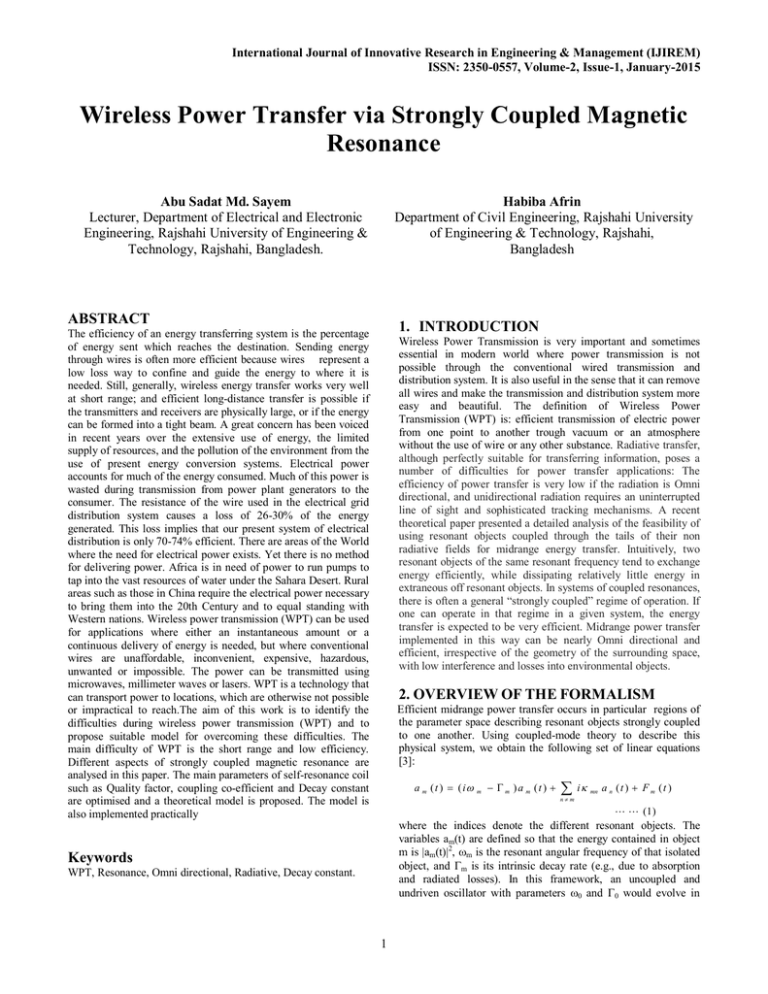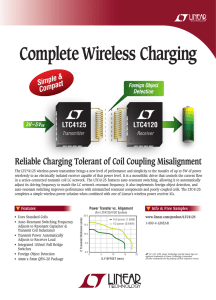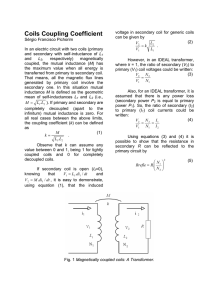Wireless Power Transfer via Strongly Coupled Magnetic Resonance
advertisement

International Journal of Innovative Research in Engineering & Management (IJIREM) ISSN: 2350-0557, Volume-2, Issue-1, January-2015 Wireless Power Transfer via Strongly Coupled Magnetic Resonance Abu Sadat Md. Sayem Lecturer, Department of Electrical and Electronic Engineering, Rajshahi University of Engineering & Technology, Rajshahi, Bangladesh. Habiba Afrin Department of Civil Engineering, Rajshahi University of Engineering & Technology, Rajshahi, Bangladesh ABSTRACT 1. INTRODUCTION The efficiency of an energy transferring system is the percentage of energy sent which reaches the destination. Sending energy through wires is often more efficient because wires represent a low loss way to confine and guide the energy to where it is needed. Still, generally, wireless energy transfer works very well at short range; and efficient long-distance transfer is possible if the transmitters and receivers are physically large, or if the energy can be formed into a tight beam. A great concern has been voiced in recent years over the extensive use of energy, the limited supply of resources, and the pollution of the environment from the use of present energy conversion systems. Electrical power accounts for much of the energy consumed. Much of this power is wasted during transmission from power plant generators to the consumer. The resistance of the wire used in the electrical grid distribution system causes a loss of 26-30% of the energy generated. This loss implies that our present system of electrical distribution is only 70-74% efficient. There are areas of the World where the need for electrical power exists. Yet there is no method for delivering power. Africa is in need of power to run pumps to tap into the vast resources of water under the Sahara Desert. Rural areas such as those in China require the electrical power necessary to bring them into the 20th Century and to equal standing with Western nations. Wireless power transmission (WPT) can be used for applications where either an instantaneous amount or a continuous delivery of energy is needed, but where conventional wires are unaffordable, inconvenient, expensive, hazardous, unwanted or impossible. The power can be transmitted using microwaves, millimeter waves or lasers. WPT is a technology that can transport power to locations, which are otherwise not possible or impractical to reach.The aim of this work is to identify the difficulties during wireless power transmission (WPT) and to propose suitable model for overcoming these difficulties. The main difficulty of WPT is the short range and low efficiency. Different aspects of strongly coupled magnetic resonance are analysed in this paper. The main parameters of self-resonance coil such as Quality factor, coupling co-efficient and Decay constant are optimised and a theoretical model is proposed. The model is also implemented practically Wireless Power Transmission is very important and sometimes essential in modern world where power transmission is not possible through the conventional wired transmission and distribution system. It is also useful in the sense that it can remove all wires and make the transmission and distribution system more easy and beautiful. The definition of Wireless Power Transmission (WPT) is: efficient transmission of electric power from one point to another trough vacuum or an atmosphere without the use of wire or any other substance. Radiative transfer, although perfectly suitable for transferring information, poses a number of difficulties for power transfer applications: The efficiency of power transfer is very low if the radiation is Omni directional, and unidirectional radiation requires an uninterrupted line of sight and sophisticated tracking mechanisms. A recent theoretical paper presented a detailed analysis of the feasibility of using resonant objects coupled through the tails of their non radiative fields for midrange energy transfer. Intuitively, two resonant objects of the same resonant frequency tend to exchange energy efficiently, while dissipating relatively little energy in extraneous off resonant objects. In systems of coupled resonances, there is often a general “strongly coupled” regime of operation. If one can operate in that regime in a given system, the energy transfer is expected to be very efficient. Midrange power transfer implemented in this way can be nearly Omni directional and efficient, irrespective of the geometry of the surrounding space, with low interference and losses into environmental objects. 2. OVERVIEW OF THE FORMALISM Efficient midrange power transfer occurs in particular regions of the parameter space describing resonant objects strongly coupled to one another. Using coupled-mode theory to describe this physical system, we obtain the following set of linear equations [3]: a m ( t ) ( i m m ) a m (t ) i mn a n (t ) F m (t ) nm (1 ) where the indices denote the different resonant objects. The variables am(t) are defined so that the energy contained in object m is |am(t)|2, m is the resonant angular frequency of that isolated object, and m is its intrinsic decay rate (e.g., due to absorption and radiated losses). In this framework, an uncoupled and undriven oscillator with parameters 0 and 0 would evolve in Keywords WPT, Resonance, Omni directional, Radiative, Decay constant. 1 Wireless Power Transfer via Strongly Coupled Magnetic Resonance time as . exp(i0t-0t). The mn = nm are coupling coefficients between the resonant objects indicated by the subscripts, and Fm(t) are driving terms. We limit the treatment to the case of two objects, denoted by source and device, such that the source (identified by the subscript S) is driven externally at a constant frequency, and the two objects have a coupling coefficient. Work is extracted from the device (subscript D) by means of a load (subscript W) that acts as a circuit resistance connected to the device, and has the effect of contributing an additional term w to the unloaded device object’s decay rate D. The overall decay rate at the device is therefore ′D = D + W. The work extracted is determined by the power dissipated in the load, that is, 2w |aD(t)|2. Maximizing the efficiency of the transfer with respect to the loading w, given Eq.1 is equivalent to solving an impedance matching problem. One finds that the scheme works best when the source and the device are resonant, in which case the efficiency is [3]: W a D S a S 2 theory decay constant for the coil is therefore = (Ro + Rr)/2L, and its quality factor is Q = /2. We find the coupling coefficient DS by looking at the power transferred from the source to the device coil, assuming a steady-state solution in which currents and charge densities vary in time as exp(it) [3]: P DS W 2 1 D S D D S S D 2 between the centers of the coils is much larger than their characteristic size, scales with the D-3 dependence characteristic of dipole-dipole coupling. Both and are functions of the frequency, and / and the efficiency are maximized for a particular value of f, which is in the range 1 to 50 MHz for typical parameters of interest. Thus, picking an appropriate frequency for a given coil size, as we do in this experimental demonstration, plays a major role in optimizing the power transfer. 2 W 1 D ( 2) The efficiency is maximized when W/D = [1 + (2/SD)]1/2. It is easy to show that the key to efficient energy transfer is to have 2/SD > 1. This is commonly referred to as the strong coupling regime. Resonance plays an essential role in this power transfer mechanism, as the efficiency is improved by approximately 2/D 2 (~106 for typical parameters) relative to the case of inductively coupled nonresonant objects. 4. ANALYSIS OF THE THEORIES Let us assume a copper coil 5 . 8 10 7 S / m of length 30m and number of turns 150.If cross sectional area is 2 10 4 m 2 and radius of the coil is 15 cm then we get from Eq.(3) from Eq.(4) R 0 2 . 48 10 3 and 3. THEORETICAL MODEL FOR SELF-RESONANT COILS R r 1353 10 Our experimental realization of the scheme consists of two selfresonant coils. One coil (the source coil) is coupled inductively to an oscillating circuit; the other (the device coil) is coupled inductively to a resistive load. Self-resonant coils rely on the interplay between distributed inductance and distributed capacitance to achieve resonance. The coils are made of an electrically conducting wire of total length l and wound into a helix of n turns, radius r, and height h. A coil with n turns and made of a material with conductivity , we modify the standard formulas for Ohmic (Ro) and radiation (Rr) resistance accordingly [3]: 2H 34 4 36 10 then 84 decay ……....(6) and Q 806 .If inductance is constant 0 .5 quality 31 1 . 48 10 factor 3 0 . 55 10 84 1 ……....(7) If mutual inductance M=2mH and L s 0 . 2 mH , L D 10 mH then coupling co-efficient =0.5ω………………..(8) 0 l .......... .......... .......... .....( 3 ) 2 4 a 2 2 r 4 2 h n (4 ) 3 3 c c 12 The first term in Eq. 4 is a magnetic dipole radiation term (assuming r << 2c/, where c is the speed of light); the second term is due to the electric dipole of the coil and is smaller than the first term for our experimental parameters. The coupled-mode Rr 2 0 . 62 10 3 338 10 34 4 9 10 84 2 We can see the results graphically as follows R0 . J D ( r ) .......... ...( 5 ) Where M is the effective mutual inductance, f is the scalar potential, A is the vector potential, and the subscript S indicates that the electric field is due to the source. We then conclude from standard coupled-mode theory arguments that DS = SD , 1/2 L s 0 . 2 mH , = M/[2(LSLD) ]. When the distance D W 2 D S D S 1 drd r 4 J r S r r r 0 S 3 r r 0 r r i MI S I D .......... .......... 2 D W a D drE r . J r dr A r r . J r 0 0 2 International Journal of Innovative Research in Engineering & Management (IJIREM) ISSN: 2350-0557, Volume-2, Issue-1, January-2015 length of the coil, high conductivity and large cross sectional area coil element is a solution to this problem. A simple experiment had been done at the laboratory to show the effect of frequency on transmission range. We have done a simple project of LED lighting wirelessly. In this project we had used two copper coils. We made an oscillator by L-C circuit. One copper coil was connected to the oscillator and other was connected to the LED. We observed the results for various conditions for varying frequency and distance. Figure 1: Decay constant vs. frequency Figure 3: Circuit for LED lighting Figure 4: Input voltage waveform Figure 2: Coupling co-efficient vs. frequency Figure1 shows that with the increase of frequency coupling coefficient increases to a large scale but Figure 2 shows that with the increase of frequency decay constant increases to a very small amount. At the increase in frequency quality factor decreases but at too slow rate that the effect can be neglected. 5. DISCUSSION AND PROPOSED MODEL From the above discussion we have come in a conclusion that efficient power transfer can take place between two self-resonant coils of equal resonant frequency. For efficient power transfer we must consider some factors. The quality factor, coupling coefficient and decay constant are major factors to be considered. All of them are functions of frequency. So operating at high frequency gives better result. Number of turns is an important factor. The number of turns increases radiation resistance so decay constant also increases, it also lowers quality factor. So solid conductor gives a solution to this problem. The length of the coil is a factor. The Ohmic resistance of the coil is proportional to the Figure 5: Output voltage waveform The experimental result of two self-resonant coils (primary coil 50 turns and secondary coil 150 turns) at two different frequencies is as follows: 3 Wireless Power Transfer via Strongly Coupled Magnetic Resonance 7. CONCLUSIONS From the diverge analysis of our research we succeed to take several decisions concerning the performance of wireless power transfer. The main problem of wireless power transfer is it’s low range and low efficiency. Strongly coupled magnetic resonance is a good solution to this problem. In systems of coupled resonances, there is often a general “strongly coupled” regime of operation. If one can operate in that regime in a given system, the energy transfer is expected to be very efficient. For efficient power transfer we must consider some factors. The quality factor , coupling co-efficient and decay constant are major factors to be considered. All of them are function of frequency. The increase in frequency increase quality factor and coupling co-efficient but also increase decay constant, so we must select a frequency for which coupling co-efficient is greater than decay constant and quality factor is also better. The number of turns increases radiation resistance so decay constant also increases, it lowers quality factor, solid conductor gives a solution to this problem. The Ohmic resistance of the coil is proportional to the length of the coil, high conductivity and large cross sectional area coil element is a solution to this problem. Considering all of the above factors efficient wireless power transfer between two coils can be possible.We had designed and implemented a model successfully. The practical result was as same like that of theory. It was not possible to implement the entire proposed model practically due to the limitation of the availability of the equipments. But from the theoretical analysis and simple experimental result it can be said that considering all of the above factors and selecting proper parameters of the equipments efficient wireless power transfer between two coils can be possible. Figure 6: Graph of output power vs. distance for 8 kHz signal. 8. FUTURE WORK By developing suitable transmitting and receiving coils power can be transmitted to long distance and more than one receivers. We can make our transmission and distribution system wireless where wired system is not accessible like in islands. Solar power satellite system can be a good solution of future energy crisis which can be a good application of wireless system. REFERENCES Figure 7: Graph of output power vs. distance for 30 kHz signal. [1]. P.E. Glaser «An Overview of the Solar Power Satellite Opinion», IEEE Transactions on Microwave Theory and Techniques, Vol. 40, No.6, June 1992, P. 1230. [2]. R. T. David Microwave Link Transport 30 kW DC over 1 mile. Microwaves. Oct. 1975. P. 9. [3]. Andre Kurs,Aristeidis Karalis,Robert Moffatt,J.D Joannopoulos,Peter Fisher,Marin Soljacic, “Wireless Power Transfer Via Strongly Coupled Magnetic Resonances”,http://www.sciencemag.org,Vol. 317, 6 July 2007. [4]. G. Pignolet, N. Kaya Lan Sn Luk J-D. Y. Naruo, V. Vanke Demonstrating SPS-IdR Studies in Reunion Island, Program and Abstracts of the WPT’95 Conference in Kobe (Japan) p. 15-2. Space Enegy and Transportation (USA) v. 1 No 3, p. 168. [5]. M. Nagamoto, S. Sasaki, Y. Naruo, V.A. Vanke The Work of the Japan Institute of Space Researthes in Space Energetics. Sov. Fiz.Uspekhi, V.37, No.6, p. 589. [6]. S.S. Shaposhnikov, B.Z. Katsenelenbaum, R.B. Vaganov, V.A. Permjakov «Innovative Approach to the Small From the above experimental result it is seen that transmission range increases with the increase of frequency that is the same result that tells our theory. 6. EFFECT OF EXTERNAL OBJECTS A detailed and quantitative analysis of the effect of external objects on our scheme is beyond the scope of this work, but we note here that the power transfer is not visibly affected as humans and various everyday objects, such as metals, wood, and electronic devices large and small, are placed between the two coils—even in cases where they completely obstruct the line of sight between source and device. External objects have a noticeable effect only when they are within a few centimeters from either one of the coils. Some materials (such as aluminum foil, Styrofoam, and humans) mostly just shift the resonant frequency, which can in principle be easily corrected with a feedback circuit; other materials (cardboard, wood, and polyvinyl chloride) lower Q when placed closer than a few centimeters from the coil, thereby lowering the efficiency of the transfer. 4 International Journal of Innovative Research in Engineering & Management (IJIREM) ISSN: 2350-0557, Volume-2, Issue-1, January-2015 Divergence Wave Beam», Report 4-2 at the Second Wireless Power Transmission Conference (WPT’95), 1995 (Kobe, Japan), It was published in Space Energy and Transportation (SET), Vol.2, No., 4, 1997, P.189. [7]. Garmash V.N., Shaposhnikov S.S, "Matrix Method Synthesis of Transmitting Antenna for Wireless Power Transmission". IEEE Trans. On Aerospace and Electronic Systems, 36. 4. 1142-1148. 2000. [8]. Castelvecchi, D. (July 21, 2007) The Power of Induction, Science News. Vol. 172, lss. 3. [9]. Gregg E. Maryniak, “ Status of international experimentation in wireless power transmission”, Sunset energy counsel, Solar energy Vol. 56 1996. [10]. R. Bryan ERB, “ International cooperation for the acquisition of space based energy”, Solar Energy Vol. 56 1996. [11]. Djuradj Bubimir and Aleksandar Marincic, “Research Activities and future trends of microwave wireless power transmission”, International symposium Nikola Tesla, 2006. [12].Andrey P. Smakhtin, Valentin V. Rybakov, “Comparative analysis of wireless systems as alternative to high voltage power lines for global terrestrial power transmission” , IEEE, 1996. 5


